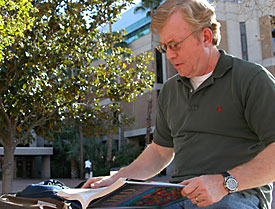 |
|
DEREKH FROUDE/Arizona Daily Wildcat
|
Elementary education junior Mark Hannah studies outside the Main Library Wednesday. Hanna, 53, worked in retail before he decided to come to UA.
|
|
By Shelley Shelton
Arizona Daily Wildcat
Friday March 14, 2003
For them, it is the opposite of peer pressure.
Several have families to support, while others are retired. Some feel invisible in their regular classes.
They are the older, non-traditional student population of UA, and like their younger counterparts, they seek ways to fit in, some more successfully than others.
"We are not part of the pack," said Lee Bishop, a 36-year-old psychology freshman. "Even in the best of situations, there is a large gap in basic behavior and understanding that makes it difficult to connect beyond brief chats about your mutual class or teacher. I feel lost in a sea of people I cannot connect with because of my age."
Approximately 5,000 non-traditional students attend UA, according to Commuter Student Affairs, which is also the home of the 25+ Cats, a student club for those students who are older than 25.
For these students, finding time to seek each other out amidst pressure and responsibilities from the world outside of school is difficult.
With increasing budget cuts, the older students' biggest untapped resource is themselves, said Danielle Roberts, 28, a married mother of two and former student senator who graduated in December.
"It can be hard because of the time factor, but we need to create resources for each other and ourselves," Roberts said.
Additionally, some non-traditional students believe that the larger portion of the UA community does not acknowledge them through clubs, organizations or social activities.
"There's nothing really focused for older students," said Anne Pagel, a higher education graduate student who coordinates 25+ Cats activities. Pagel graduated from UA five years ago, at the age of 30.
"They're not really looking for the social end of it as much as they're looking for support," she said.
Others are in a position to lend support.
"School is my life," said Mark Hanna, 53, an elementary education junior who retired from a 30-year retail career three years ago and transferred to UA last fall.
Hanna is treasurer of the Future Teachers Club and the student representative for the College of Education College Council.
"I'm in a really enviable position," he said. "I am always amazed by the people who juggle a job and school as well as kids."
When he gets involved with campus organizations, Hanna purposely leaves the top positions for the younger students who have more to gain from the experience, but he believes that everyone can benefit from the mixing of generations.
"If you can help someone younger who may not have had the same experiences as you, you should do it," he said.
Roberts said she had to focus on serving as a resource to younger students.
"I made (the younger students) aware of things that wouldn't even occur to them about what we experience," she said.
She added that many of them benefited from seeing people without the same opportunities they enjoyed, who had to overcome different hardships.
To be so involved on campus, Roberts said, required her to be "super-organized and prioritize. Sunday was my family day. That meant no homework or study groups. It was just a day with my kids."
She also credited her husband for his supportiveness while she made it through.
Some younger classmates asked Roberts to hang out last week, so she knows there is hope.
"It was so nice to be appreciated and respected for my experience and at the same time treated as an equal," she said. "It just takes a few open-minded people to get an interaction going."

